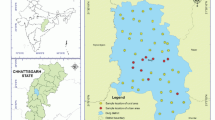Summary
The present knowledge about dose components in Switzerland and their ranges is reviewed. Considerable ranges are found for doses induced by radon decay-products and by cosmic and terrestrial radiation. Yearly doses from radon decay-products show average values between about 1 and 20 mSv in different communities and individual values up to about 150 mSv. The reliability of these average values is, however, limited, because radon concentrations have been measured up to now only in a small number of houses, and because corrections of the raw data are necessary, increasing the uncertainty of the results. Doses from terrestrial and cosmic radiation show locally variable values between about 0.5 and 1.5 mSv per year. These doses are mainly derived from outdoor measurements. Therefore, these results also are only of limited use in possible epidemiological applications.
Résumé
Ce travail constitue une mise à jour des connaissances sur les contributions à la dose d'irradiation et leur variabilité en Suisse. Des variations considérables ont été mises en évidence pour les doses induites par les descendants du radon, le rayonnement cosmique et les composantes terrestres. Les doses annuelles occasionnées par les descendants du radon montrent des valeurs moyennes comprises entre 1 et 20 mSv dans les différentes communes suisses, des valeurs ponctuelles pouvant atteindre jusqu'à 150 mSv. La fiabilité de ces moyennes est limitée du fait du nombre encore restreint de maisons examinées et compte tenu d'une incertitude additionnelle des résultats impliquée par des corrections nécessaires au niveau des données brutes. Les doses dues à la radiation terrestre et cosmique mettent en évidence des variations locales s'échelonnant d'environ 0.5 à 1.5 mSv par an. Ces doses résultent principalement des mesures en plein air. C'est pourquoi l'exploitation de ces résultats pour des applications épidémiologiques s'avère également limitée.
Zusammenfassung
Die Dosis-Komponenten in der Schweiz und deren Schwankungsbreiten sind aus heutiger Sicht zusammengestellt. Beachtliche Variationen zeigen sich bei den durch Radon-Folgeprodukte bewirkten Dosen und bei den Dosen infolge kosmischer und terrestrischer Strahlung. Die durch Radon-Zerfallsprodukte bewirkten mittleren Jahresdosen liegen in verschiedenen Schweizer Gemeinden zwischen ca. 1 und 20 mSv; für Einzelpersonen kommen Werte bis ca. 150 mSv vor. Die Zuverlässigkeit der Mittelwerte ist jedoch begrenzt, weil bis jetzt Radon-Konzentrationen nur in wenigen Häusern gemessen wurden und weil an den Messwerten Korrekturen vorgenommen werden müssen, was die Unsicherheit der Resultate erhöht. Die Dosen, die durch terrestrische und kosmische Strahlung verursacht werden, zeigen örtlich variable Werte zwischen ca. 0.5 und 1.5 mSv pro Jahr. Diese Dosiswerte wurden vorwiegend durch Messungen im Freien bestimmt. Deshalb können auch diese Resultate nur mit Einschränkungen in allfälligen epidemiologischen Studien verwendet werden.
Similar content being viewed by others
References
Federal Comission for the Survey of Radioactivity (KUeR): 29. Bericht für die Jahre 1985–1986 zuhanden des Bundesrates. Berne: Bundesamt für Gesundheitswesen, 1989.
Federal Commission for the Survey of Radioactivity (KUeR): 30. Bericht für die Jahre 1987 und 1988 zuhanden des Bundesrates. Berne: Bundesamt für Gesundheitswesen, in press.
Surbeck H, Völkle H, Zeller W. Radon in Switzerland. Proc. Int. Symp. on Radon and Radon reduction technology, EPA, Philadelphia, April 2–5 1991, in press.
Crameri R, Furrer D, Schuler Ch. Radonquellen und Mechanismen des Radon-Transportes;Rybach L, Medici F. Geologische Aspekte der Radon-Strahlenbelastung in der Schweiz. In: Crameri R, Burkart W. (Ed.). Radon und Strahlenbiologie der Lunge. PSI-Bericht 22, 49–79. Villigen: Paul Scherrer Institute 1989. Schweiz. PSI-Bericht Nr. 22, Januar 1989, Ed. R. Crameri und W. Burkart.
Bundesamt für Gesundheitswesen: Schlussbericht zum Radon Programm in der Schweiz RAPROS, in preparation.
Crameri R, Brunner HH, Buchli R, Wernli C, Burkart W. Indoor Rn Levels in Different Geological Areas in Switzerland. Health Physics 1989;57:1: 29–38.
United Nations Scientific Committee on the Effects of Atomic Radiation. Sources, effects and risks of ionizing radiation. 1988 Report. New York: United Nations (Publ. E.88.IX.7), 1988.
Poretti G. Naturlich bedingte Strahlenbelastung der Schweizer Bevölkerung. Schweiz. med. Wschr. 1978;108: 235–248.
International Commission on Radiological Protection: Lung Cancer Risk from Indoor Exposures to Radon Daughters. ICRP Publication 50. Oxford: Pergamon Press, 1987 (Annals of the ICRP 17, Vol. 1).
Murith C, Völkle H, Piller G, Surbeck H, Ribordy L. In-situ Gamma Spectroscopy in Switzerland using a Portable Gamma Ray Spectrometer. In: Feldt W. The radioecology of natural and artificial radionuclides. Proc. XVth Regional Congress of IRPA. Köln 1989: Verlag TUV Rheinland, pp 389–394.
Author information
Authors and Affiliations
Rights and permissions
About this article
Cite this article
Loosli, H.H., Völkle, H. Components of total irradiation dose in Switzerland and their ranges. Soz Präventivmed 36, 286–293 (1991). https://doi.org/10.1007/BF01359159
Issue Date:
DOI: https://doi.org/10.1007/BF01359159




